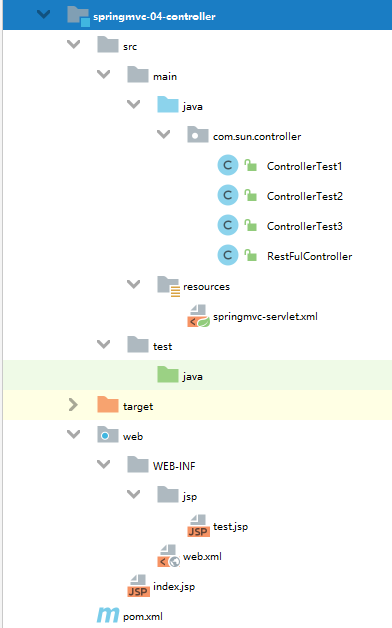a. 转发是一个请求一次响应,重定向是两次请求两次响应;
b. 转发地址栏不发生变化,重定向地址栏发生变化(会显示重定向后的地址);
c. 转发只能转发到本项目中其他控制器(在学习JavaWeb的时候,说的是:转发只能转发到本项目中其他Servlet),重定向不仅能重定向到本项目中的其他控制器(或其他Servlet),还能重定向到其他项目;
d. 转发是服务器端的行为,只需给出转发的相对路径,重定向需要给出请求URI(即包含项目名)。
a. 若需要地址栏发生变化,则使用重定向;
b. 转发会携带数据,重定向不会携带数据。
c. 转发可以转发到JavaWeb项目的/WEB-INF目录下面的页面,但是重定向不可以重定向到/WEB-INF目录下面的页面(资源),因为/WEB-INF目录下面的资源是不可以直接访问的,由于转发是服务器端行为,所以可以转发到
/WEB-INF目录下面的资源,但是重定向相当于发送了两次请求,重定向到/WEB-INF目录下面的资源,就相当于直接访问了/WEN-INF目录下面的资源,所以是不被允许的。

package com.sun.controller;
import org.springframework.stereotype.Controller;
import org.springframework.web.bind.annotation.GetMapping;
import org.springframework.web.bind.annotation.RequestMapping;
import javax.servlet.ServletException;
import javax.servlet.http.HttpServletRequest;
import javax.servlet.http.HttpServletResponse;
import java.io.IOException;
/**
* 使用ServletAPI进行数据输出到界面、转发和重定向
*
* @author sunhongguang
* @create 2020-11-25-23:04
*/
@Controller
@RequestMapping(path = "/c2")
public class ControllerTest2 {
/**
* 使用response向页面输出数据
*
* @param request
* @param response
* @throws IOException
*/
@GetMapping(path = "/t1")
public void test1(HttpServletRequest request, HttpServletResponse response) throws IOException {
response.getWriter().println(request.getSession().getId());
}
/**
* 使用request.getRequestDispatcher(path).forward(request,response) 进行转发
* 注意:转发的路径前面不用写项目名 (本项目的项目名称是/springmvc)
* @param request
* @param response
* @throws ServletException
* @throws IOException
*/
@GetMapping(path = "/t2")
public void test2(HttpServletRequest request, HttpServletResponse response) throws ServletException, IOException {
request.setAttribute("msg", request.getSession().getId());
request.getRequestDispatcher("/WEB-INF/jsp/test.jsp").forward(request, response);
}
/**
* 使用request.getRequestDispatcher(path).forward(request,response) 进行转发,转发到本项目中的其他控制器(比如转发到 t2)
* 注意:转发到其他控制器时,只能写相对路径(即:要转发的路径前面不能带 / )
*
* @param request
* @param response
* @throws ServletException
* @throws IOException
*/
@GetMapping(path = "/t2_1")
public void test2_1(HttpServletRequest request, HttpServletResponse response) throws ServletException, IOException {
request.getRequestDispatcher("t2").forward(request, response);
}
/**
* 使用response.sendRedirect(paht)进行重定向
*
* @param request
* @param response
*/
@GetMapping(path = "/t3")
public void test3(HttpServletRequest request, HttpServletResponse response) throws IOException {
response.sendRedirect("/springmvc/index.jsp");
}
/**
* 使用response.sendRedirect(paht)进行重定向
* 注意:要重定向的路径前面不能带 / ,即要使用相对路径
*
* @param request
* @param response
* @throws IOException
*/
@GetMapping(path = "/t3_1")
public void test3_1(HttpServletRequest request, HttpServletResponse response) throws IOException {
response.sendRedirect("t3");
}
}
package com.sun.controller;
import org.springframework.stereotype.Controller;
import org.springframework.web.bind.annotation.GetMapping;
import org.springframework.web.bind.annotation.RequestMapping;
import javax.servlet.http.HttpServletRequest;
/**
* 通过SpringMVC实现转发和重定向(不需要视图解析器)
* @author sunhongguang
* @create 2020-11-26-0:04
*/
@Controller
@RequestMapping(path = "/c3")
public class ControllerTest3 {
/**
* 直接写要转发的路径(不用带项目名)
* @return
*/
@GetMapping(path = "/t1")
public String test1(HttpServletRequest request){
request.setAttribute("msg", request.getSession().getId());
return "/WEB-INF/jsp/test.jsp";
}
/**
* 直接写要转发的路径(不用带项目名,转发的路径前面写上forward)
* @return
*/
@GetMapping(path = "/t1_1")
public String test1_1(HttpServletRequest request){
request.setAttribute("msg", request.getSession().getId());
return "forward:/WEB-INF/jsp/test.jsp";
}
/**
* 转发到另外一个请求(比如转发到 /t1),不带forward
* @return
*/
@GetMapping(path = "/t1_2")
public String test1_2(){
return "t1";
}
/**
* 转发到另外一个请求(比如转发到 /t1),带forward
* @return
*/
@GetMapping(path = "/t1_3")
public String test1_3(){
return "forward:t1";
}
/**
* 重定向需要加上redirect,不用写项目名
* @return
*/
@RequestMapping("/t2")
public String test2(){
return "redirect:/index.jsp";
}
/**
* 重定向需要加上redirect,
* @return
*/
@RequestMapping("/t2_1")
public String test2_1(){
return "redirect:t2";
}
}
原文:https://www.cnblogs.com/sun-/p/14039508.html